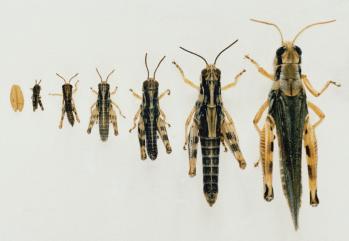
Grasshoppers belong to the insect order Orthoptera (“straight wing”), a group whose major characteristic is long hind legs, adapted for jumping. Another distinguishing feature is the presence of short antennae; this separates the order from a related order, Grylloptera (crickets, katydids, mole crickets and camel crickets), sometimes confusingly referred to as the “long-horned” grasshoppers. They have incomplete metomorphosis, with eggs giving rise to wingless nymphs, then to winged adults. In Saskatchewan and neighbouring provinces the most common orthopteran family is Acrididae, which is dominated by three major subfamilies: Oedipodinae (banded-winged grasshoppers), Gomphocerinae (slant-faced grasshoppers), and Melanoplinae (spine-breasted grasshoppers). Collectively these comprise approximately eighty different species that vary in shape, size, colour, and behaviour. Most species belonging to the first two subfamilies are noticeable by their distinctive sounds or vivid “flash” wing colorations displayed during courtship. These features, along with morphology, help to identify particular species. In contrast, members of Melanoplinae are virtually silent, and species are generally identified by examining male genitalic characters. Diets also vary. A few species such as the sage grasshopper, Hypochlora alba , feed almost exclusively on one plant genus, Artemisia in this case. Most grasshoppers, however, are mixed feeders, with some (e.g., the migratory grasshopper, Melanoplus sanguinipes) showing a preference for leafy plants and others (e.g., the clear-winged grasshopper, Camnula pellucida) for grasses. The majority of species (e.g., the migratory grasshopper) overwinter as eggs; a few (e.g., the speckled rangeland grasshopper, Arphia conspersa) as nymphs.
The migratory grasshopper, two-striped grasshopper (Melanoplus bivitattus), Packard’s grasshopper (Melanoplus packardii), and clear-winged grasshopper are routinely counted among five major grasshopper pests on the prairies; in outbreak years they cost tens of millions of dollars in annual crop damage. In the 19th century, this list included the legendary Rocky Mountain grasshopper, Melanoplus spretus, whose numbers in 1877 were estimated in the trillions. The species’ extinction in 1902, an unprecedented phenomenon in the history of agriculture, remains a mystery—although a plausible explanation centres on the destruction of egg-laying habitats in riparian areas (their preferred oviposition habitat), brought about by the introduction of agriculture. Grasshopper outbreaks occur approximately every ten to twelve years, with some local infestations lasting a few years. The Research Branch of Agriculture and Agri-Food Canada, together with their provincial counterparts, regularly monitor grasshopper infestations and produce annual reports and maps (on their web-site) that predict levels of risk for different regions of the prairies. This is a complex exercise that takes into account factors both abiotic (e.g., weather, snow cover, moisture levels) and biotic (e.g., last year’s numerical abundance, resource availability).
Despite economic concerns, there is an increasing awareness of the role of grasshoppers as grazing herbivores in grassland communities. As part of the prairie landscape, many nesting birds (e.g., burrowing owl, horned lark, American kestrel, and Swainson’s hawk) and small mammals (e.g., mouse, shrew, vole, Richardson’s ground squirrel) include grasshoppers in their daily diets. While grasshopper control may be necessary from an agricultural viewpoint, eradication of this important and fascinating group of insects could have untold effects on the prairie landscape. In certain societies, grasshoppers are consumed as food; some keep them as pets. Grasshoppers have even been personified in literature and poetry. In Regina, a large metal sculpture of “Reginald the Grasshopper,” designed by prairie artist Wilf Perrault, adorns the corner of Albert Street and Leopold Crescent.
William Chapco